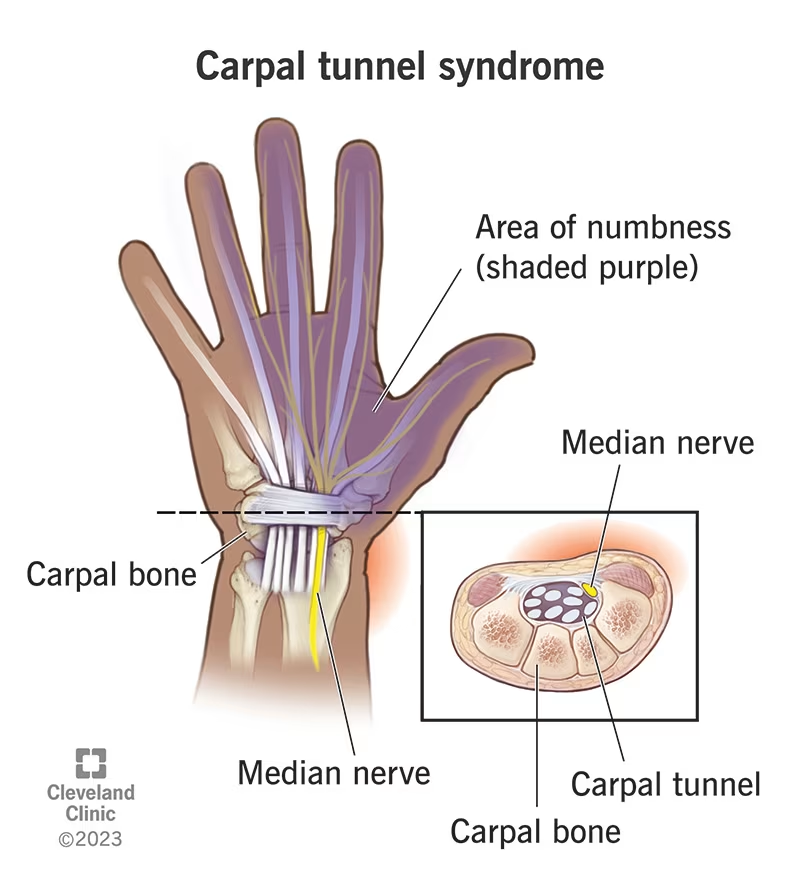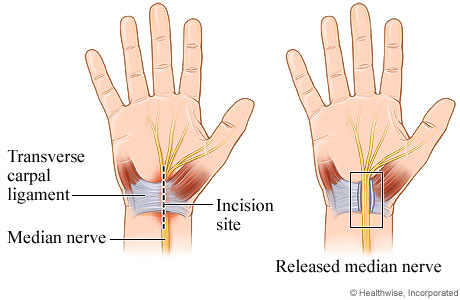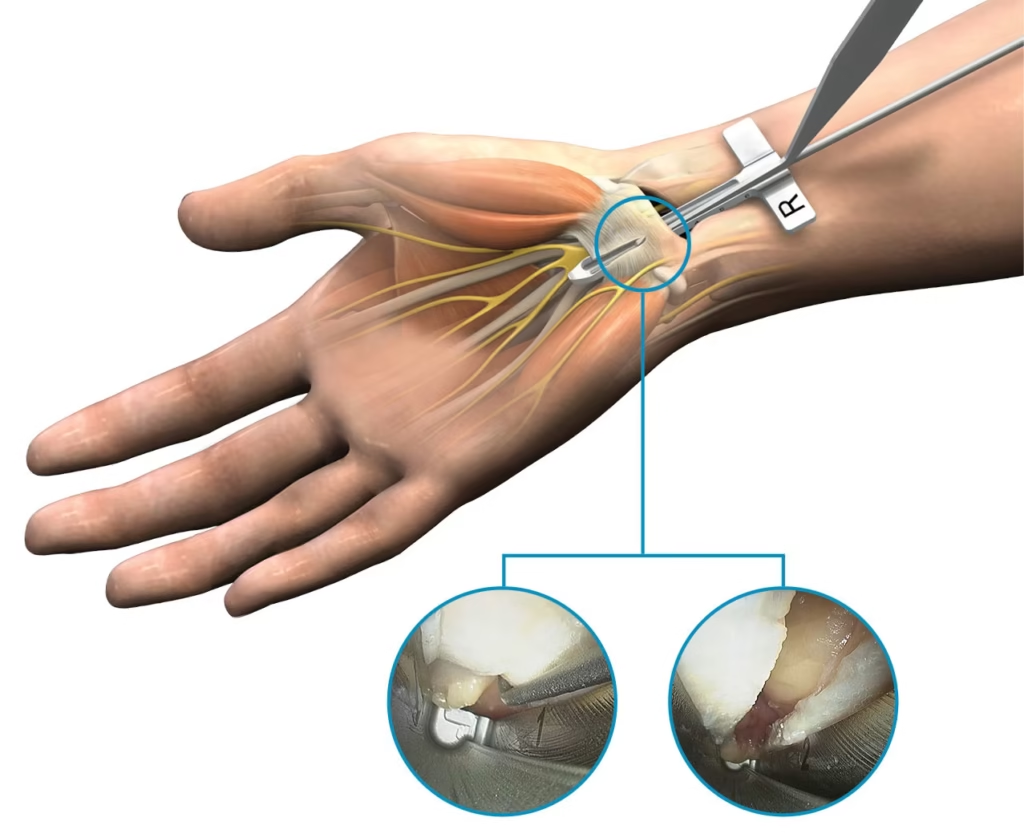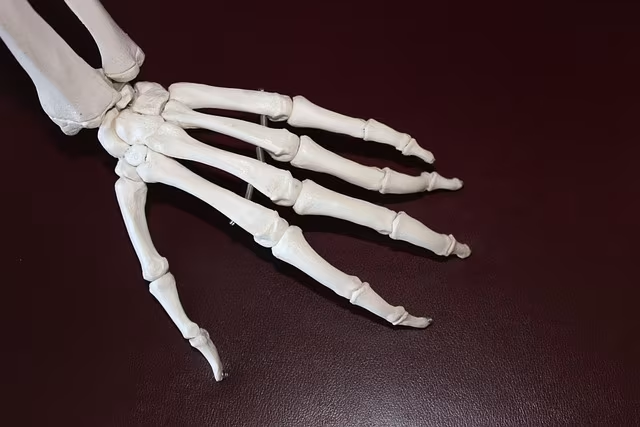Carpal tunnel syndrome (CTS) is a common condition affecting many Singaporeans, particularly those whose professions or hobbies involve repetitive hand and wrist movements.
If you’re experiencing hand numbness, tingling sensations, or weakness, understanding this condition and its treatment options can help you make informed decisions about your care.
This comprehensive guide explores carpal tunnel syndrome, its causes, symptoms, diagnosis methods, and the range of treatments available in Singapore.
What is Carpal Tunnel Syndrome?

Carpal tunnel syndrome occurs when the median nerve, which runs from your forearm into your hand through a narrow passageway called the carpal tunnel, becomes compressed or squeezed at the wrist.
The carpal tunnel is a rigid passageway of ligament and bones at the base of the hand that houses the median nerve and tendons.
This median nerve provides sensation to the palm side of your thumb, index, middle fingers, and half of your ring finger.
It also provides the nerve impulses to move certain muscles in your thumb and fingers.
When the median nerve is compressed, it can cause numbness, tingling, pain, and eventually weakness in the affected fingers and thumb.
CTS is the most common peripheral nerve entrapment syndrome, affecting approximately 1% of the general population. It has a higher incidence among women, elderly individuals, and pregnant patients due to various physiological factors.
Read more: Which Orthopedic Doctor in Singapore Should You Consider?
Signs and Symptoms of Carpal Tunnel Syndrome
The symptoms of carpal tunnel syndrome typically develop gradually and often worsen over time without proper treatment. The most common symptoms include:
- Numbness and tingling in the thumb, index, middle, and half of the ring finger
- Symptoms that worsen at night, often disrupting sleep
- Hand weakness and tendency to drop objects
- Pain that may radiate up the arm toward the shoulder
- A sensation that the hand feels “swollen” even without visible swelling
- Temporary relief from shaking or flicking the wrist
Many patients report that symptoms are more severe at night, often because people sleep with their wrists bent, increasing pressure on the median nerve. The weakness in hand grip is due to the compromised function of the thumb muscles, which are controlled by the median nerve.
If left untreated, carpal tunnel syndrome can lead to permanent nerve damage, resulting in constant numbness, permanent weakness, and atrophy (wasting) of the thumb muscles, severely impacting hand function and dexterity.
Related article: ACL Reconstruction Surgery in Singapore: Causes, Costs
Risk Factors and Causes
Several factors can increase your risk of developing carpal tunnel syndrome. These include:
Anatomical Factors
Wrist fracture or dislocation can alter the space within the carpal tunnel and irritate the median nerve.
Some people are born with a smaller carpal tunnel, making them naturally more susceptible to nerve compression.
Health and Medical Conditions
Various health conditions can contribute to carpal tunnel syndrome. Diabetes increases susceptibility to nerve damage through peripheral neuropathy.
Inflammatory conditions like rheumatoid arthritis can affect the tendons in the wrist, causing swelling and pressure on the median nerve.
Both hypothyroidism and hyperthyroidism can affect nerve function. Obesity has been associated with increased risk of CTS, as has kidney failure through fluid retention that can increase pressure within the carpal tunnel.
Gout can contribute through crystal deposits and inflammation that compress the nerve.
You might like: Osteoarthritis Treatment in Singapore: Symptoms, Prevention
Lifestyle and Occupational Factors
Your occupation and daily activities can significantly impact your risk. Jobs or hobbies that involve repetitive hand movements, especially with the wrist bent, can irritate tendons and cause swelling.
Extended typing or mouse use with poor ergonomics can contribute to CTS. Working with vibrating tools causes prolonged exposure to vibration that can harm nerves.
Keeping the wrist in unnatural positions for extended periods increases pressure on the median nerve.
Biological Factors
Hormonal changes during pregnancy can cause fluid retention, potentially increasing pressure in the carpal tunnel.
Women are three times more likely than men to develop carpal tunnel syndrome, possibly due to having smaller carpal tunnels.
The risk of CTS increases with age, with peak prevalence in the 45-60 age group.
You might be interested: Sports Doctors in Singapore: Guide to Finding a Suitable Specialist
Diagnosis of Carpal Tunnel Syndrome
Proper diagnosis of carpal tunnel syndrome is essential for effective treatment. In Singapore, hand specialists and orthopedic surgeons typically use several methods to confirm a diagnosis.
During a physical examination, your doctor will check for tenderness, swelling, and signs of nerve compression.
They will evaluate sensation in your fingers and muscle strength in your hand. Specific tests include Tinel’s Sign, where the doctor taps on the median nerve at the wrist to check for tingling in the fingers, and Phalen’s Maneuver (wrist flexion test), where you press the backs of the hands together with fingers pointed down for 1-2 minutes to see if symptoms are reproduced.
Electrodiagnostic tests are frequently used for confirmation. A nerve conduction study measures how fast electrical signals travel through the median nerve.
Slowed conduction indicates nerve compression. The test involves placing small electrodes on the skin to deliver a mild electrical current and measure the nerve’s response.
An electromyogram (EMG) evaluates the electrical activity of muscles when contracting and at rest, confirming muscle weakness resulting from nerve damage.
While not always necessary, imaging tests may be used to rule out other causes of wrist pain.
Ultrasound can visualize the median nerve directly and identify abnormalities. X-rays are useful if wrist fracture or arthritis is suspected. MRI provides detailed images of tissues and can identify other causes of nerve compression.
Related article: Osteoarthritis Treatment in Singapore: Symptoms, Prevention
Treatment Options for Carpal Tunnel Syndrome in Singapore
Treatment approaches for carpal tunnel syndrome typically depend on the severity of symptoms. Singapore offers a range of both conservative and surgical options.
Conservative (Non-Surgical) Treatments
For mild to moderate cases, doctors typically recommend starting with non-surgical approaches:
- Wrist Splinting: Wearing a brace to keep the wrist in a neutral position, especially during sleep
- Activity Modification: Avoiding or limiting activities that worsen symptoms
- Anti-inflammatory Medications: Reducing pain and swelling with NSAIDs
- Steroid Injections: Corticosteroids injected into the carpal tunnel to reduce inflammation
- Physical Therapy: Specific exercises to improve wrist strength and flexibility
Resting and modifying activities that worsen symptoms can help reduce pressure on the median nerve. Making ergonomic adjustments to your workspace setup, especially keyboard and mouse positions, can prevent excessive wrist bending.
Maintaining good posture is important to avoid straining neck and shoulder muscles, which can indirectly affect the nerves in your arms and hands.
Some evidence suggests high-dose Vitamin B6 may benefit nerve health.
Acupuncture has shown effectiveness in alleviating pain, numbness, and inflammation, and may help restore motor dexterity in some patients.
Special nerve gliding exercises are designed to help the median nerve move more freely within the carpal tunnel.
You might like: Rotator Cuff Tear Treatment in Singapore
Surgical Treatments
When conservative treatments don’t provide sufficient relief or when there’s evidence of severe nerve compression, surgery may be necessary. In Singapore, two main surgical approaches are available:
Open Carpal Tunnel Release (OCTR)

This is the most common surgical approach for treating carpal tunnel syndrome. It involves making a 3-5cm incision in the palm to access and cut the transverse carpal ligament, which releases pressure on the median nerve.
Recovery typically takes about 2 weeks for the incision to heal, but full recovery and return to normal activities may take 3-4 months. The procedure is performed under local anesthesia as a day surgery.
Endoscopic Carpal Tunnel Release (ECTR)

This less invasive approach uses a small 7-10mm incision at the wrist and employs a small camera (endoscope) to guide the surgeon in visualizing and cutting the ligament.
The benefits include faster recovery (typically half the time of open surgery), less postoperative pain, earlier return to normal activities, and minimal scarring.
Like the open procedure, this is performed under local anesthesia as a day surgery. Studies have shown reduced complication rates with this method when performed by experienced surgeons.
In cases where initial carpal tunnel release surgery is unsuccessful, microsurgical neurolysis may be recommended.
This advanced procedure releases tight scar tissue around the median nerve and sometimes involves transferring soft tissue to the bare median nerve to prevent recurrent scarring.
You might like: Tennis Elbow Treatment in Singapore: Causes, Symptoms, Recovery
Recovery and Post-Operative Care
For patients who undergo surgery, proper post-operative care is essential for optimal recovery. Initially, the hand will remain bandaged for a couple of days, possibly with a sling for support.
Keeping the hand elevated for 48 hours helps reduce swelling. Gentle movement of fingers, shoulder, and elbow should begin soon after surgery to prevent stiffness.
Patients are encouraged to gradually increase hand usage while avoiding forceful motions.
Many experience improvement in numbness within a week, though complete recovery may take several months, particularly for cases with severe pre-surgical symptoms.
Outcomes and Success Rates
The prognosis for carpal tunnel syndrome depends largely on how early treatment begins.
Many patients with mild CTS experience improvement with non-surgical approaches, particularly when started early in the course of the condition.
For those requiring surgery, more than 90% of patients with carpal tunnel syndrome can be completely cured if treated within 6 months of symptom onset.
Patients who have had symptoms for several years may not experience complete resolution but typically show significant improvement in sleep quality and hand function.
Surgical complications, including nerve injury, infection, or sensitive scarring, occur in approximately 5% of cases. In about 5% of cases, symptoms may return several years after successful treatment, which may require additional intervention.
Prevention of Carpal Tunnel Syndrome
Several strategies can help reduce the risk of developing carpal tunnel syndrome:
- Maintain good hand and wrist posture, especially during computer use
- Take short breaks every hour during repetitive activities
- Keep the wrist in a neutral position rather than bent up or down
- Use ergonomic tools and equipment designed to reduce strain
- Properly manage conditions that increase risk, such as diabetes and obesity
Keeping hands and wrists warm is beneficial, as cold environments can increase discomfort and stiffness.
For those who must perform repetitive hand movements regularly, learning proper techniques and using appropriate tools can make a significant difference in preventing this condition.
When to See a Doctor
It’s important to consult a hand specialist or orthopedic surgeon if you experience persistent numbness, tingling, or pain in your fingers or hand.
Symptoms that interfere with your normal activities or sleep, weakness in your thumb, fingers, or hand, or symptoms that don’t improve with basic self-care measures all warrant medical attention.
Early diagnosis and treatment are crucial for preventing permanent nerve damage and achieving the best possible outcomes.
In Singapore, there are many experienced hand specialists who can provide expert care for carpal tunnel syndrome.
Frequently Asked Questions
What exactly happens in carpal tunnel syndrome?
Carpal tunnel syndrome occurs when the median nerve, which passes through a narrow passage in your wrist called the carpal tunnel, becomes compressed.
This compression happens when surrounding tissues swell or thicken, putting pressure on the nerve. The median nerve provides sensation to your thumb, index, middle, and part of your ring finger, and controls some of the muscles in your thumb.
When compressed, it causes numbness, tingling, pain, and eventually weakness in these areas.
How can I tell if my hand numbness is carpal tunnel syndrome?
While only a medical professional can diagnose carpal tunnel syndrome definitively, characteristic symptoms include numbness and tingling in the thumb, index, middle fingers, and half of the ring finger (but not the little finger).
These sensations often worsen at night or when holding objects like phones or books. Shaking your hand might temporarily relieve symptoms.
If you experience these symptoms, especially if they’re persistent or worsening, consult a hand specialist for proper diagnosis.
Is carpal tunnel syndrome permanent?
Carpal tunnel syndrome is not necessarily permanent, especially if diagnosed and treated early. With appropriate treatment, many patients experience complete resolution of symptoms.
However, if left untreated for an extended period, carpal tunnel syndrome can lead to permanent nerve damage, resulting in persistent numbness, weakness, and muscle atrophy. Early intervention is key to preventing long-term damage.
Which treatment option is best for carpal tunnel syndrome?
The best treatment depends on the severity of your symptoms and how long you’ve had them. For mild cases, conservative approaches like wrist splinting, activity modification, and occasional anti-inflammatory medication may be sufficient.
For moderate cases, steroid injections might provide relief. Severe cases or those that don’t respond to conservative treatment typically require surgical intervention.
An experienced hand specialist can recommend the most appropriate treatment based on your specific situation.
How long is the recovery period after carpal tunnel surgery?
Recovery timelines vary depending on the surgical technique and individual factors. For open carpal tunnel release, the incision typically heals in about 2 weeks, but full recovery may take 3-4 months.
Endoscopic carpal tunnel release generally has a faster recovery, with many patients returning to light activities almost immediately and achieving full recovery in half the time of open surgery.
Most patients notice improvement in numbness within the first week, though complete resolution of all symptoms may take longer.
Can carpal tunnel syndrome come back after surgery?
While carpal tunnel release surgery is generally very effective, recurrence is possible in about 5% of cases.
Recurrence typically happens several years after the initial surgery and may be due to scar tissue formation or persistent conditions that contributed to the initial problem.
Maintaining good wrist ergonomics and managing underlying health conditions can help reduce the risk of recurrence.
How can I manage carpal tunnel symptoms at home?
For temporary relief at home, you can apply ice packs for 10-15 minutes every hour, wear a wrist splint (especially at night), take breaks from repetitive activities, shake your hand gently when symptoms flare, maintain neutral wrist positions, and use ergonomic tools designed to reduce wrist strain.
However, these measures should complement, not replace, professional medical advice and treatment.
Are there any exercises that can help with carpal tunnel syndrome?
Yes, certain exercises may help, particularly nerve gliding exercises that help the median nerve move more freely through the carpal tunnel. These should be performed several times daily.
Simple wrist stretches, gentle wrist rotations, and finger exercises can also help maintain flexibility and reduce symptoms.
However, these exercises should be performed under the guidance of a healthcare professional, as improper execution could potentially worsen symptoms.
Who is most at risk for developing carpal tunnel syndrome?
Women are three times more likely than men to develop carpal tunnel syndrome, possibly due to having smaller carpal tunnels. Other high-risk groups include people with diabetes, rheumatoid arthritis, thyroid disorders, or obesity; pregnant women; adults over 45; and those whose occupations involve repetitive wrist motions (like assembly line workers, keyboard users, hairstylists, and construction workers using vibrating tools).
What happens if carpal tunnel syndrome is left untreated?
Untreated carpal tunnel syndrome typically worsens over time. Initially intermittent symptoms may become constant and more severe.
Progressive median nerve damage can lead to permanent numbness, weakness, and eventual atrophy of the thumb muscles.
This muscle wasting affects fine motor skills and grip strength, making everyday tasks like buttoning shirts or picking up small objects increasingly difficult.
Permanent nerve damage is irreversible, even with surgery, highlighting the importance of early treatment.
How are carpal tunnel syndrome and computer use related?
Prolonged computer use with poor ergonomics can contribute to carpal tunnel syndrome.
Typing and mouse use often involve repetitive wrist movements and sometimes awkward wrist positions that increase pressure within the carpal tunnel.
However, the relationship is complex and often involves multiple factors.
Using ergonomic keyboards and mice, maintaining proper wrist position (neutral, not bent up or down), taking regular breaks, and proper desk setup can significantly reduce risk.
What’s the difference between open and endoscopic carpal tunnel surgery?
Open carpal tunnel release involves a 3-5cm incision in the palm to directly access and cut the transverse carpal ligament. Recovery typically takes longer, with limitations on hand use for 3-4 months.
Endoscopic carpal tunnel release uses a much smaller incision (7-10mm) at the wrist and employs a tiny camera to visualize and cut the ligament.
Benefits of endoscopic surgery include faster recovery, less post-operative pain, earlier return to activities, and minimal scarring.
Both procedures are effective, and the choice depends on surgeon expertise and individual patient factors.
Does Singapore’s healthcare system cover carpal tunnel syndrome treatment?
In Singapore, carpal tunnel syndrome treatments are generally covered under various healthcare financing schemes, including MediSave, MediShield Life, and private insurance.
The extent of coverage depends on your specific plan.
Consultations, diagnostic tests, and surgical procedures at public hospitals are typically subsidized for Singapore citizens and permanent residents.
It’s advisable to check with your insurance provider and healthcare facility about specific coverage details and potential out-of-pocket expenses.
How do I choose the right hand specialist in Singapore?
When selecting a hand specialist in Singapore, consider their qualifications (look for specialists certified in hand surgery or orthopedics with specific training in hand conditions), experience (particularly with carpal tunnel treatments), hospital affiliations, and patient reviews.
Ask about their approach to treatment—some may favor conservative methods first, while others might recommend surgical intervention sooner.
Personal comfort with the doctor and their communication style is also important, as treatment may involve ongoing care.

